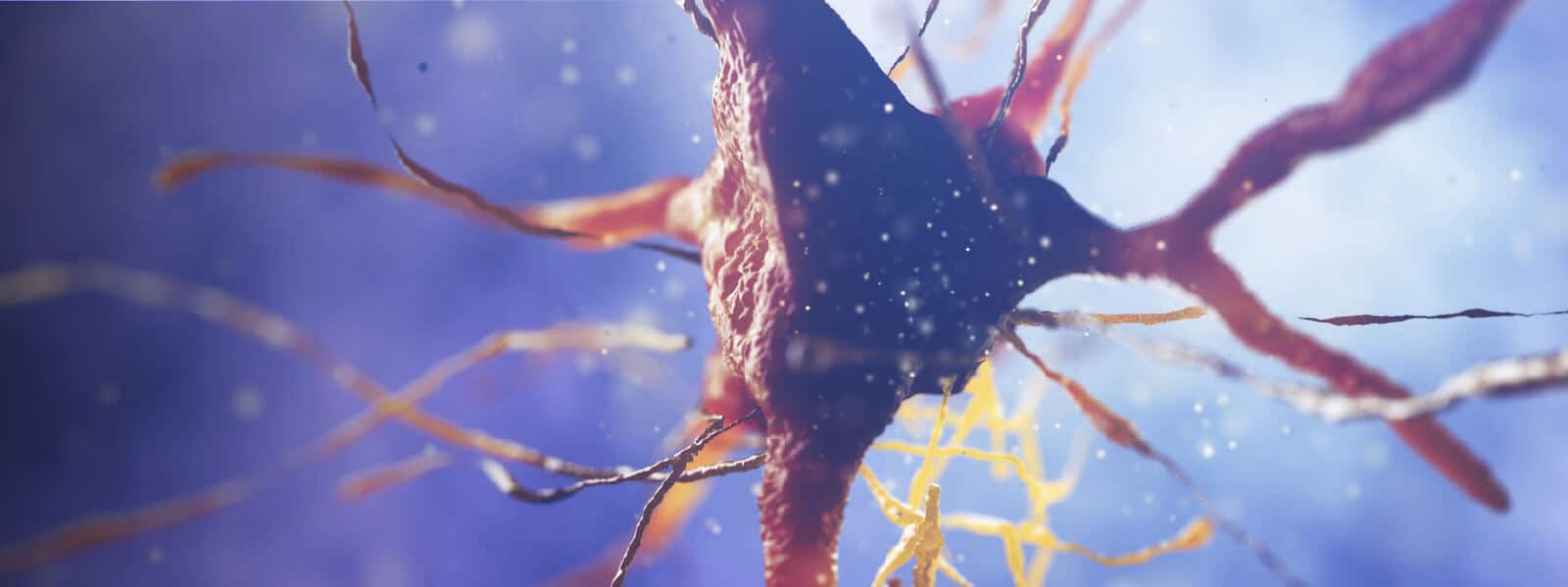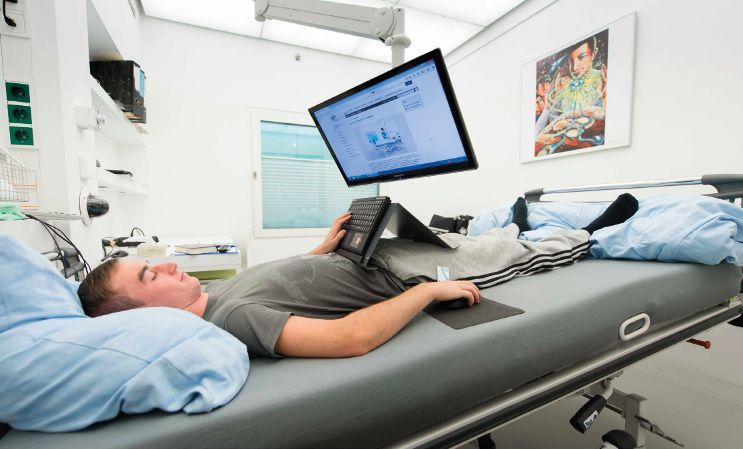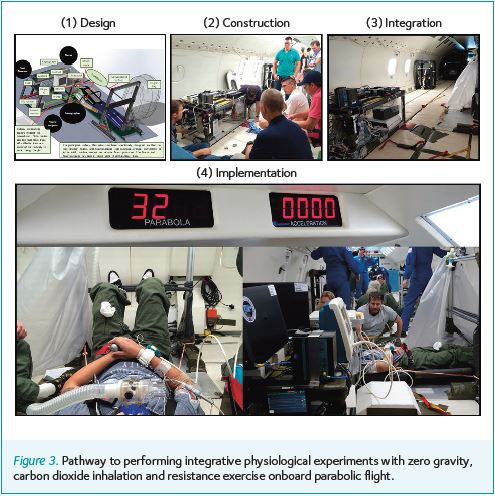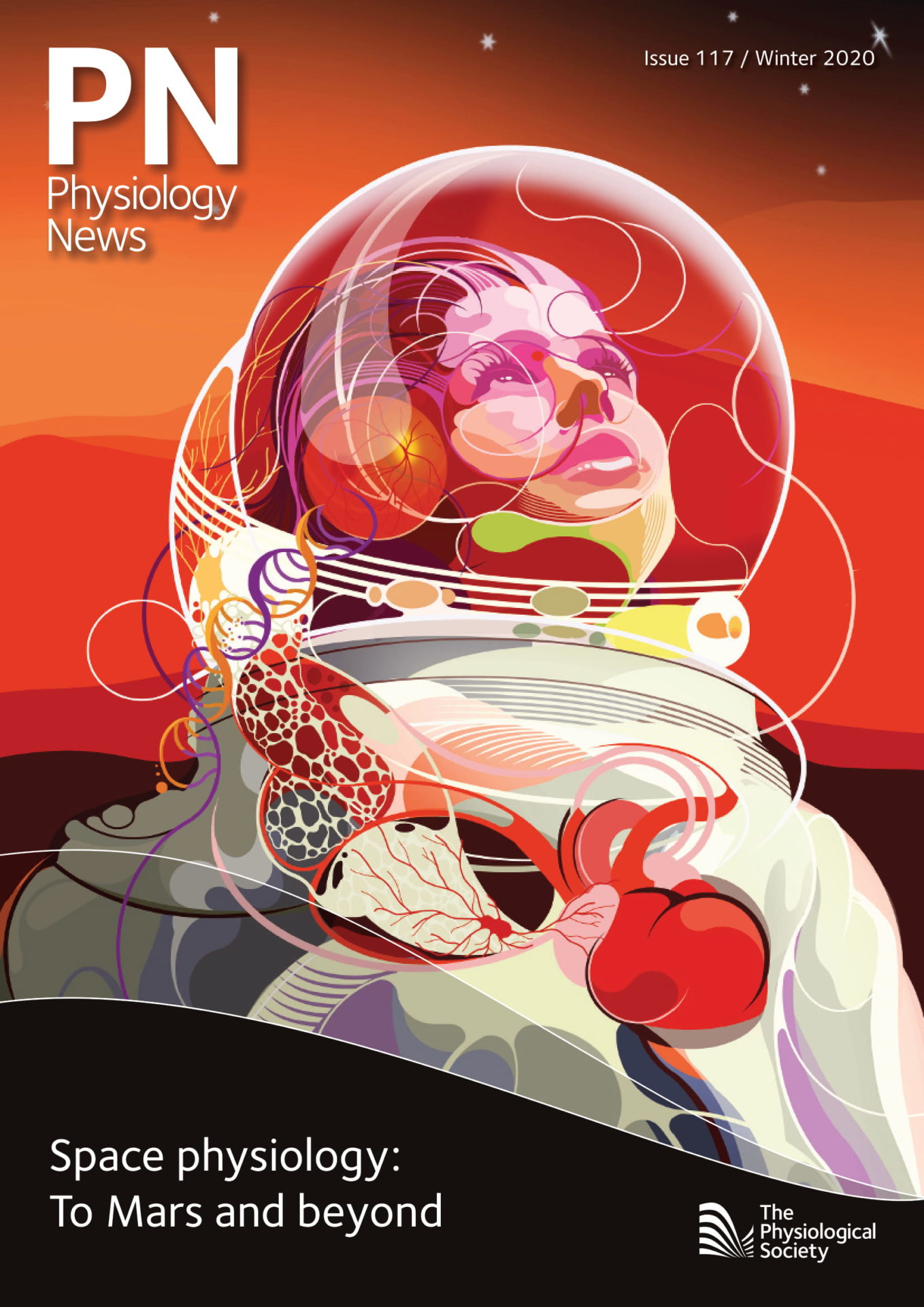
Physiology News Magazine
Don’t lose sight under pressure
Cranial consequences of a life without gravity
Features
Don’t lose sight under pressure
Cranial consequences of a life without gravity
Features
Justin S Lawley
University Innsbruck, Austria
Benjamin D Levine
Texas Health Presbyterian Dallas, USA
https://doi.org/10.36866/pn.117.22
Although humans evolved under the constant weight of Earth’s gravity, they appear to be particularly susceptible to changes in gravitational gradients. An example of this is the so-called spaceflight-associated neuro-ocular syndrome, which was first reported in astronauts that experienced impairments in their vision during and after long-duration missions onboard the International Space Station. The symptoms were initially thought to result from intracranial hypertension due to a microgravity-dependent redistribution of fluid volume to the upper parts of the body. While the existence of this syndrome indicates that Earth’s gravity field has an important influence on the structure and function of the optic apparatus, it was not until recently that intracranial pressure was experimentally measured during microgravity.


Manned exploration of the galaxy is a dangerous business, not only because of the technical and logistical issues surrounding space travel (to date, all deaths in human space flight have been due to catastrophic loss of the crew vehicle), but due to prolonged exposure to isolation and confinement, hostile and closed environmental conditions, radiation (see Limoli p. 26 and Whittaker p. 36) and importantly the lack of gravity (see Mekjavic p. 30). Life on Mars will no doubt be tenuous, as astronauts will be living in only three-eighths of Earth’s gravitational force for many months to years. Thus, a broad scientific understanding of how the human body copes with prolonged periods of reduced gravitational loads will be imperative for mission success.
How does gravity affect the cardiovascular system?
In the upright posture, gravity acts on the long head-to-foot fluid column (Gz) within all three major circulations: arterial, venous and cerebrospinal fluid. For example, arterial blood pressure at the level of the brain is ~80 mmHg, at heart level ~100 mmHg and at the level of the feet ~200 mmHg. In stark contrast, in the supine posture, the effect of gravity is limited to the short chest-to-spine fluid column (Gx) with arterial blood pressure being ~100 mmHg at the level of the brain, heart and foot.
These large changes in fluid pressures and subsequent redistribution of fluid volume to the lower extremities makes standing up a challenge to the cardiovascular system most humans do not consider on a daily basis, as complex involuntary reflex adjustments make it possible. Yet, after long-duration space missions or prolonged periods of bedrest, standing up in Earth’s gravity is difficult and fainting is common. Thus, physiologists have taken a keen interest in how the human body adapts to both microgravity and bedrest and its implications for blood pressure regulation on Earth (see Norsk p. 40).

Spaceflight associated neuro-ocular syndrome
Careful examination of astronauts experiencing neuro-ocular syndrome noted flattening of the eyeball, folds in the choroid, widening of the optic nerve, cotton wool spots on the retina and, in a few cases, swelling of the optic disc (Mader et al., 2011). These observations, reminiscent of patients with intracranial hypertension (i.e. pathologically high pressure in the brain), alongside the known headward fluid shifts in microgravity, rang alarm bells with concerns of raised intracranial pressure as the underlying mechanism of what was initially termed Visual Impairment Intracranial Pressure (VIIP) syndrome. However, like the great British detective Sherlock Holmes advocates, “There is nothing more deceptive than an obvious fact”. Thus, the space flight community agreed that only through precise measurements of regional pressures in the human body during both real and simulated microgravity can the pathophysiological role of raised intracranial pressure be substantiated.
Attacking the problem of accurately measuring regional pressures
Precise measurement of pressure within the human body requires the insertion of a catheter or needle into the fluid compartment of interest. So, measuring pressure inside the brain of healthy volunteers in microgravity is a real challenge! Fortuitously, Benjamin Levine recalled a group of patients from his days as a medical resident whom had an Ommaya reservoir (catheter placed from the lateral ventricle to a reservoir under the scalp) inserted for the delivery of prophylactic central nervous system chemotherapy as part of their treatment for haematologic malignancy. In many of these patients, the reservoir is left in place permanently, even after complete recovery. Intracranial pressure can therefore be measured by placing a small butterfly needle into the reservoir while sutured securely to allow free movement and accurate recordings. For our study we recruited five men and three women with Ommaya reservoirs, and combined measurements of intracranial pressure with central venous and arterial blood pressures, measured at the level of the right atrium of the heart via catheterisation of the brachial vein and determined by non-invasive finger artery photoplethysmography and brachial artery electronic sphygmomanometry, respectively (Fig. 1).
Quantifying the effect of various changes in gravitational gradients
We set out to answer several fundamental research questions. The first question we asked was simply what happens to intracranial, arterial and venous pressures with normal changes in posture on Earth? The second question we asked was how these regional pressures would be affected by long periods of cephalad fluid shifts with simulated microgravity. The third question was how intracranial, arterial and venous pressures change during freefall-generated acute “microgravity” over the course of a series of earthbound parabolic flights. Furthermore, we wished to assess how these test conditions may be affected by the addition of atmospheric carbon dioxide (0.7%, v/v) and resistance exercise, both of which may increase intracranial pressure on Earth and during microgravity.

While we assessed the first question by asking participants to change posture from sitting upright to lying down while obtaining the relevant measurements, the two other questions required some thoughtful logistics and rehearsal. For example, the second question addressing the effects of protracted cephalad fluid shifts was assessed by placing participants on -6° head-down tilt bedrest for 24 hours to simulate microgravity (Fig. 2). Whereas the third question was much more elaborate, as the participants needed to be secured to avoid free floating during parabolic flight, but no pressure could be applied to the abdomen, as this is known to increase both central venous and intracranial pressures. Moreover, performing resistance exercise without the counter force of gravity is challenging. A typical flight campaign is flown over 4 – 5 consecutive days with one flight per day. Prior to flight, all research equipment needs to be stowed securely and once at a cruising altitude deployed, set-up and calibrated in under a few minutes. With the team at Wyle Laboratories, Inc, we built and set-up the necessary equipment (Fig. 3) and repeated the set-up protocol and measurement procedures in a mock environment for a week prior to each campaign. Staffing each flight typically involved one participant, a study director, an ultrasonographer, a research nurse, a neurosurgeon and a research engineer with a typical participant schedule as follows:
Day 1: ~12:00 pm, pick up participant from Houston airport and obtain Ellington airfield badge identification; ~2:00 pm, individualised equipment set-up and subject familiarisation, ~5:00 pm, participant briefing on flight procedures.
Day 2: 6:00 am, instrumentation of invasive pressure monitors; 7:00 am, equipment check and calibration; 8:00 am, subject instrumentation with non-invasive devices; 8:30 am, pre-flight and medical briefing; 9:00 am, board plane, take off and data acquisition; 12:00 pm, post-flight debrief; ~1:00 pm, participant tour of Johnson Space Center, thereafter take participant to Houston airport for departure.

Is pressure in the brain elevated in space? It’s all relative
The findings from the first series of studies showed that on Earth, intracranial pressure is high when lying down compared to sitting upright. Thus, pressure in the brain on Earth during a typical day is split into roughly 16 hours in the upright posture where pressure is low and 8 hours in the supine posture during sleep where pressure is “relatively” high. With 24 hours on -6° head-down tilt bedrest, intracranial pressure changed minimally and there was no hint of a progressive rise over time. However, contrary to expectations, when lying down onboard parabolic flight, intracranial pressure actually fell as soon as the flight entered the microgravity phase of each parabola. Yet, although intracranial pressure fell, it did not fall to values observed in the upright posture on Earth. Therefore, when unaffected by Earth’s gravity, intracranial pressure is constantly in between the states of upright and supine postures found on Earth. Moreover, independent of gravitational load, exposure to a mild increase in atmospheric carbon dioxide added very little to intracranial pressure, while resistance exercise only transiently elevated intracranial pressure, not dissimilar to that observed on Earth. Ultimately, if we consider a typical 24-hour day on Earth, intracranial pressure is likely relatively elevated in space, but pathologically high intracranial pressures, such as those observed in patients with intracranial hypertension, are unlikely (Lawley et al., 2017).
Our findings uncovered the possibility that as human evolution occurred under the constant pull of gravity, and humans habitually spend their waking hours upright with the brain and eyes at the top of a long fluid column, the optical structures and their function may require fluctuations in pressure and volume to operate normally / optimally. However, this raises a fourth perplexing question: why do participants who take part in long periods of bedrest (up to 60 days) not report changes in their vision, as pressure in the brain would be relatively high and constant for the entire duration? We addressed this question by a keen observation that during previous bedrest studies participants were typically allowed a pillow to aid comfort (Fig 2), which means that while the heart is still -6° below the feet, the head is elevated and experiences relative gravitational effects. We found that wadding even a very small pillow substantially reduces pressure in the brain in the -6° head-down tilt position, therefore providing a simple explanation for the lack of signs and symptoms of space-flight-associated neuro-ocular syndrome in previous bedrest studies. Indeed our observations were later verified by Laurie et al. (2019) who showed development of optic disc oedema and increased retinal thickness in subjects after 30 days of strict -6° head-down tilt bedrest without the use of a pillow or repositioning to eat during meals.
Conclusion
Carrying the great weight of the world often symbolises disadvantageous consequences, but our publication in The Journal of Physiology (Lawley et al., 2017) highlights that components of human physiology may actually require the interaction between Earth’s gravitational force and habitual changes in posture to function optimally.
Preserving astronauts’ visual acuity is an area of considerable concern for long-term space flight (i.e. manned mission to Mars) and a high-priority area of research for many space agencies. Therefore, experimental models of SANS will be important for testing potential countermeasures, as well as investigating the pathophysiology and novel therapies for Earthbound hypertensive and diabetic patients who develop optic disc oedema.
Justin S Lawley won The Journal of Physiology Early Investigator Prize in 2017. See a list of all winners here: bit.ly/380eWWm
References
Laurie SS et al. (2019). Optic disc edema after 30 days of strict head-down tilt bed rest. Ophthalmology 126(3), 467 – 468. DOI: 10.1016/j.ophtha.2018.09.042
Lawley JS et al. (2017). Effect of gravity and microgravity on intracranial pressure. The Journal of Physiology 595(6), 2115 – 2127. DOI: 10.1113/JP273557
Mader TH et al. (2011). Optic disc edema, globe flattening, choroidal folds, and hyperopic shifts observed in astronauts after long-duration space flight. Ophthalmology 118(10), 2058 – 2069. DOI: 10.1016/j.ophtha.2011.06.021
